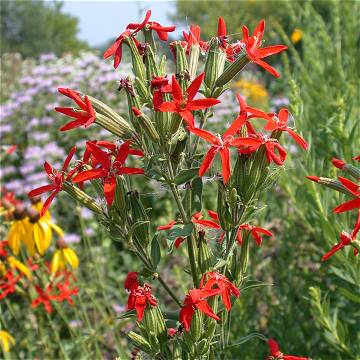

Silene regia - (image 1 of 7)
Taxonomy
Family: Caryophyllaceae
Habitat
Prairies, open woods.
Associates
In prairies with Amorpha canescens, Andropogon gerardii, Andropogon scoparius, Anemone cylindrica, Antennaria plantaginifolia, Apocynum androsaemifolium, Asclepias sullivantii, Aster ericoides, Ceanothus americanus, Coreopsis palmata, Corylus americana, Desmodium illinoense, Eryngium yuccifolium, Gentiana puberulenta, Geum triflorum, Helianthus occidentalis, Liatris aspera, Monarda fistulosa, Parthenium integrifolium, Petalostemum candidum, Petalostemum purpureum, Phlox glaberrima interior, Polygala sanguinea, Potentilla arguta, Silene stellata, Silphium intergrifolium, Silphium laciniatum, Solidago speciosa, Sorghastrum nutans, Stipa spartea, Veronicastrum virginicum.
Distribution
Ontario west to eastern MO, south to AL and GA.
Morphology
Herbaceous, taprooted perennial, to 5' high. Cauline leaves opposite, entire or slightly toothed, usually fewer than 10 pairs, ovate to oblanceolate or spatulate, to 12 cm long and 7 cm wide. Inflorescence terminal, narrow, loose cymose; calyx tubular, to 2.5 cm, glandular; petals 5, brilliant red, the auricles prominent, the tubular appendages 2-4 mm; styles 3. Fruit a dehiscent capsule.
Notes
Flowers mid July to early August
Wetland indicator: Upland
Catchfly refers to the sticky hairs on the calyx which trap insects. The purpose may be to keep non-flying insects away from the flowers. A good garden plant that is a little slow to establish. For the first year or two it grows as a tight rosette.
References
Gleason, Henry A. and A. Cronquist. 1991. Manual of Vascular Plants of
Northeastern United States
and Adjacent Canada. Second Ed.
The New York Botanical Garden. Bronx, NY
Swink, F. and G. Wilhelm. 1994. Plants of the Chicago Region.
Indiana Academy of Science. The Morton Arboretum. Lisle, Illinois.
|
Michael Hough © 2005 |